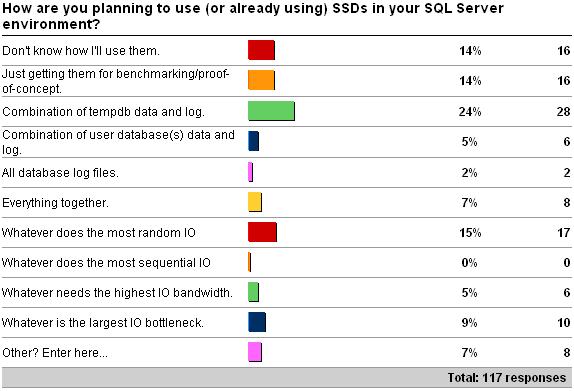
The "other" answers were (verbatim):
-
3 x 'have bought and am trying them out'
-
3 x 'not sure if we need them or not'
-
2 x 'all production servers are hosted'
-
1 x 'bought them, tried them..not good enough yet for tempdb'
-
1 x 'Have some, want more, could you really every have enough?'
-
1 x 'We get every penny from or spinning media, and have no need for SSD'

The "other" answers were (verbatim):
-
3 x 'not in the budget'
-
1 x 'I plan to buy expensive drives and throw them at you, paul! love, conor'
-
1 x 'I'm going to do the same thing Conor will do. Denny'
-
1 x 'OLAP Scale Out'
-
1 x 'Use them as cache'
-
1 x 'Using in an EMC V-MAX SAN to dynamically move high workloads to SSD temporarily'
Another unsurprising set of results that reflects what I've been hearing. One number I'd be interested in drilling deeper into is answer #3 – are people putting/planning to put tempdb on SSDs because that's what they've heard is the best thing to do, or because tempdb truly is the largest I/O bottleneck that can benefit the most from SSDs? That's a set of experiments I'd like to try out with my Fusion-io drives.
The final "other" answer is also interesting – I was talking to a couple of folks from EMC in Ireland about the V-MAX when we were there earlier this month. Very cool idea to migrate data up and down a set of devices with varying latencies (at the block level, not the file level) – I'd like to see more on how the technology copes with one-off operations like consistency checks or backups – do those IOs affect which layer a block resides in?
Anyway, hope you find these results interesting.
Thanks to all those who responded!
FONTE: By: Paul Randal
Nenhum comentário:
Postar um comentário